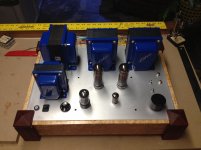This is my preliminary setup a little tuning for tight fits and I can start hardwiring. My? is on the RCA inputs(right side) do I shield these coming thru the alum. top and ground just the one lug. The switches I believe are shielded from the top and ground thru the circuit. This is a tubelab SSE
Attachments
Generally the screen (outer) of RCA should be isolated from the chassis/case for audio, ad find their ground at the appropriate place in the input circuit.
On the other hand, to reduce RF getting in the outer can be connected to the chassis by a small value capacitor - but few bother to do this.
On the other hand, to reduce RF getting in the outer can be connected to the chassis by a small value capacitor - but few bother to do this.
Hi!
You should mount the RCA inputs such that their grounds are isolated from the chassis. On the photo it looks like they are not.
Make a connection from the ground lugs of the RCA to the signal ground inside the chassis.
Best regards
Thomas
You should mount the RCA inputs such that their grounds are isolated from the chassis. On the photo it looks like they are not.
Make a connection from the ground lugs of the RCA to the signal ground inside the chassis.
Best regards
Thomas
This is my preliminary setup a little tuning for tight fits and I can start hardwiring. My? is on the RCA inputs(right side) do I shield these coming thru the alum. top and ground just the one lug. The switches I believe are shielded from the top and ground thru the circuit. This is a tubelab SSE
Hi.
Im looking for the transformers as you've used for this amp. Could you show me where to buy them?
Thanks much
I bought the transformers from edcor(just web search for it) the PT is XPWR035 and Output CXSE25-8-5k. There is a 6 week build time from edcor
The infamous "pin 1 problem" also applies to unbalanced interconnects!
If you mean that the RCA body should be connected directly to ground, I am all in favour to experimenting it first. Washers can be retrofitted laterd if really needed.
If you mean that the RCA body should be connected directly to ground, I am all in favour to experimenting it first. Washers can be retrofitted laterd if really needed.
RCA body should be ISOLATED from ground/chassis with a plastic washer both sides of chassis hole and run a wire from the RCA body (usually there's a tab where the threads are on the back of the jack) you run a wire from the ground tab over to your ground buss or star ground point which is your signal ground. No hum this way... I like to attach the signal ground on my ground buss right close to where my cathode resistor ties to ground. That's how I do it.. there are many ways, with your setup you're setting yourself up for a ground loop hum, there are many sources for the hum, which is why you want to take steps to avoid it.
RCA with washers look like this:
Chassis Mount RCA Jack Pair 091-1120
Cheers,
Bob
Bob,
Avoiding hum generally resorts to a star ground and avoiding ground loops albeit this is only a receipe, not a real philosophy, and may not the best solution in all cases.
Why not set the star ground at the RCA socket ground connected to the chassis ?
Do not forget that, if the input is stereo (twin RCA), the sockets must be close.
Avoiding hum generally resorts to a star ground and avoiding ground loops albeit this is only a receipe, not a real philosophy, and may not the best solution in all cases.
Why not set the star ground at the RCA socket ground connected to the chassis ?
Do not forget that, if the input is stereo (twin RCA), the sockets must be close.
Bob,
Avoiding hum generally resorts to a star ground and avoiding ground loops albeit this is only a receipe, not a real philosophy, and may not the best solution in all cases.
Why not set the star ground at the RCA socket ground connected to the chassis ?
Do not forget that, if the input is stereo (twin RCA), the sockets must be close.
You should read this article on the subject of star grounding. I follow that when building tube amps. To answer your question about "why not set the star ground at the RCA jack", well you don't want HT next to the signal or anywhere close by, that would guarantee hum. Best place for the ground or star ground in one of the bolts that hold the transformer to the chassis. Close to your center tap(s) and keeps your wiring simple and easy to follow. There's a certain "art" to wiring and there are some unwritten rules to follow in that regard. The more I do it the better I get but it does take practice. Signal wires and AC keep them as far away from each other as I can, ground by the PT etc...
Article:
http://www.geofex.com/article_folders/stargnd/stargnd.htm
Cheers,
Bob
Looking for a source of shoulder washers to fit RCA input with a 1/8 inch plate?
Hi Rock12,
I used these - they're inexpensive and come with the shoulder washers, ground tab and two nuts. They're available in a variety of colors, too.
REAN RCA Phono Connectors | Mouser
Bob's link has good suggestions that are quite similar to what I use to obtain a hum-free amp.
Best luck! 😎
~ Sam
- Status
- Not open for further replies.
- Home
- Amplifiers
- Tubes / Valves
- grounding RCA inputs

